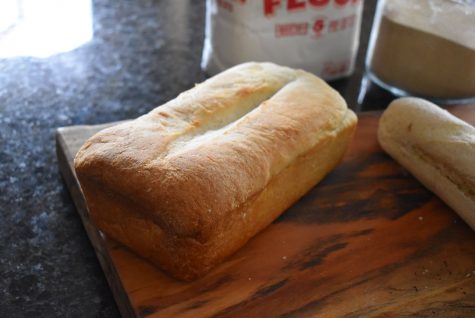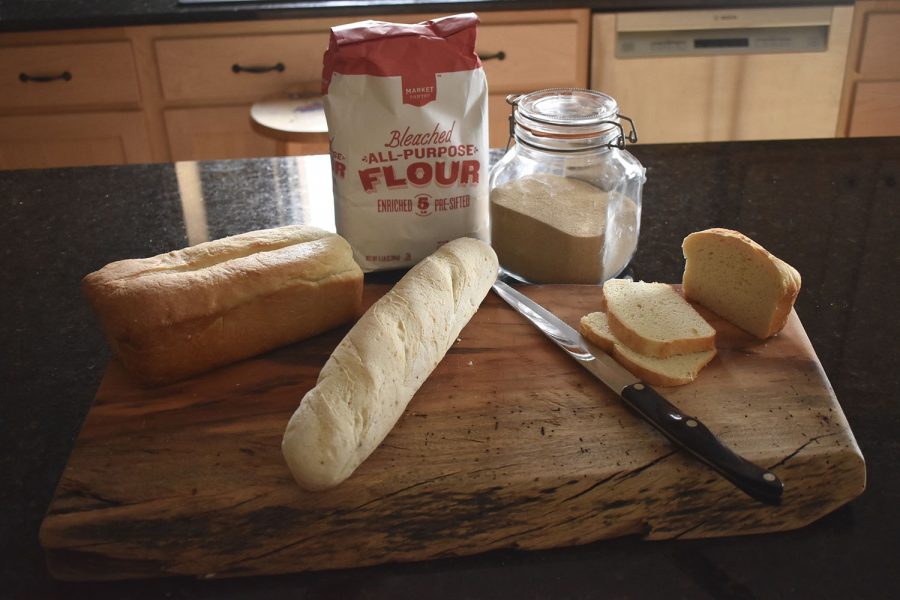Bread baking: a new way to spend quarantine
One DI Arts reporter took on the bread baking trend currently spreading across social media.
A buttermilk loaf is pictured alongside a variation of French baguette and classic white bread on Wednesday April 15, 2020. The type of flour and yeast used had a sizable effect on the outcome of the bread. Flour can affect the flavor of the bread while yeast can affect the texture and the proof of the bread.
April 15, 2020
Scrolling through Instagram and Facebook right now, it’s almost impossible not to find picture after picture of delicious, freshly baked bread. With more time available, the time-consuming process of baking has become a staple in some households during quarantine.
I decided to take part in this trend, not only out of boredom but because of my great love of baking— and bread in general.
It had been many years since I had made Primorski Uskrsne Bebe, a Croatian recipe consisting of a cute set of miniature braided bread rolls that typically feature a colorful dyed hard-boiled egg at the top. But I thought now would be as good a time as any to try this recipe again.

A buttermilk loaf is pictured alongside a baguette on Wednesday April 15, 2020. Buttermilk bread was made with buttermilk instead of oil. The buttermilk gave the bread a light and fluffy texture as well as a rich flavor.
The first step I had to take was to grind my flour, which I also had not done for a long time. While most of my baking endeavors have only required store bought flour, homemade breads — and the overall shortage of flour at the store — made making my own was the most fitting option. I used a mix of dark and light wheat berries that would work best for a slightly sweet yeast bread.
The grinder was a lot louder than I remembered, but it produced a beautiful pale brown flour by the end of the process. I began my recipe by adding yeast to hot milk (around 110 degrees) and left it to bloom while I turned to work on the base.
As I was grabbing my mixer, I realized just how many bread-baking specific tools I had. My mixer is an unusual style and had been bought specifically for making and kneading doughs, but I had used it to make just about anything as well, but like the grinder, bread making was its main purpose.
Related: Quarantine time homemade cooking challenge
I mixed together sugar, salt, melted butter, and eggs. Then I mixed in the yeast mixture and half of the flour, forming a fairly liquid, yet dough-like, mixture. I beat in the rest of the flour slowly, adding much more than I anticipated, until the dough became firm and didn’t stick to my hands.
I let the brown lump of dough rise for about an hour afterward, and even though it hadn’t quite doubled in size by that time, I decided to go ahead and start using it anyway.
I split the dough up into 36 roughly even pieces and let it rest for about five minutes while I preheated the oven to 375 degrees.
Taking three pieces at a time, I rolled each into rope and began to braid them, repeating the process until I made 12 six-inch rolls.
I decided to forgo the traditional placement of the dyed hard-boiled egg on the very end of the roll for a simpler yet still lovely piece of bread. Brushing them with a little bit of melted butter, they were ready to go into the oven for around 18 minutes.
The braids came out beautifully: light brown and shiny, ready to go with just about any meal with just enough sweetness to be delicious yet not overwhelming.














